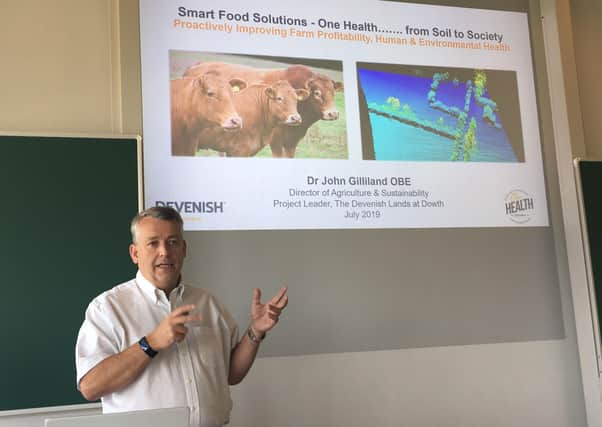On the road to carbon neutrality


The principal speaker was Dr John Gilliland, director of Agriculture and Sustainability with Devenish Nutrition.
He confirmed that production agriculture is already delivering significant climate change-related benefits for society as a whole, adding: “Our soils, woodland and hedges sequester large quantities of carbon dioxide. The challenge confronting production agriculture is that of quantifying the impact of this activity and to use this as a base line in order to plot a course towards carbon neutrality for the industry as a whole.”
Advertisement
Advertisement
Gilliland confirmed that issues such as soil health and water quality were inextricably linked with the need for farming to help deliver a sustainable future for the entire planet, citing the need to develop a new asset class within society, one comprising healthy soils and pollinators.
He commented: “As farmers, we are custodians of the countryside. We must improve the environment.”
Devenish Nutrition established its Global Innovation Centre on farmlands purchased in late 2013 near Dowth in Co Meath. The farm extends to 16s hectares. Since the beginning of 2014, Dr Gilliland and his team have been developing management systems that will allow ruminant agriculture to develop on a sustainable basis. Initial work centred on the surveying of the entire site using a combination of Lidar scanning, archaeological surveying and GPS-based soil testing technologies.
Dr Gilliland continued: “Our aim is to be carbon neutral from a beef and lamb production perspective by 2025.
Advertisement
Advertisement
“However, we already know that a stocking rate of one livestock unit per hectare will deliver a positive carbon budget for the farm as a whole. This is because the carbon sequestration levels exceed the emission of greenhouse gases from the animals. Currently, we would achieve carbon neutrality at a stocking rate of 1.25 livestock unit per hectare.
“Looking to the future, we want to evolve management systems that allow us increase the stocking rate to two livestock units per hectare across the farm while also meeting our carbon neutrality target.”
He stressed the need for international bodies to recognise the fact that farm land actively sequesters carbon, adding: “Up to now, they have only accepted the gross emission figures that relate to production agriculture. This state of affairs must be changed.”
Dr Gililand also confirmed that the pH of a mineral soil determines its carbon storage potential. He said: “Up to now it has been generally accepted that soils under permanent grassland will reach their optimal carbon storage level after twenty years. Our work at Dowth has shown this to be untrue.
Advertisement
Advertisement
“The soils on the farm have not been ploughed for 40 years. When we carried out the original survey work, the original survey work confirmed a soil carbon levels of round 2.2%. This compares with an expected value of 4.4%.
“Significantly, the soil pH value when we took over the management of the farm averaged 5.5. The optimal pH value is 6.5.
“We are currently spreading lime in order to allow us reach the optimal soil pH value. It is our expectation that soil carbon levels will increase accordingly. This assertion will, hopefully, be confirmed in 2023 when we carry out our next soil carbon survey.”
Silvopasture, according to Dr Gilliland, is a very effective way of increasing carbon sequestration levels on farms while, at the same time retaining the output that can be achieved from grassland. He commented: “Agro forestry is a different concept as it is focused on producing timber. In our own case we have planted 400 ash trees across 10% of the grassland area at Dowth.
Advertisement
Advertisement
“What we are already finding is that the trees are acting to improve the trafficability of the land they are planted on. In turn, this is allowing us to extend the grazing season later into the autumn. We can also get cattle out earlier it the spring.”
The use of multi-species swards is another management approach that Dr Gililand would advocate when it comes to improving the sustainability of a beef and lamb enterprise.
“We are currently comparing the impact of swards made up of either 6 or 12 forage species with that of a traditional grass seed mix. As part of this work, we are carrying out a micro mineral analysis of the beef produced from cattle that grazed the species-rich swards.”
Methane is the main greenhouse gas produced by ruminant animals. Significantly, Dr Gilliland believes that a number of natural feed additives – including certain algae and red seaweeds – have the potential to impact on rumen function in ways that significantly reduce methane production.
Advertisement
Advertisement
“We are trialling a number of these products at the moment,” he confirmed.
Dr Gilliand concluded: “Agriculture is often portrayed as an industry that is making a major contribution to greenhouse production around the world.
“In reality agriculture has a major role to play in sequestering greenhouse gases. This is a message that the industry must communicate to the world as a matter of priority.”
EIT Food’s ‘Focus on Farmers’ is a project aimed at delivering a sustainable, healthy and trusted food system.
It is a collaboration between ABP, Queen’s University, the University of Reading and John Deere, hosted by AgriSearch. All webinars can be viewed on the AgriSearch website.